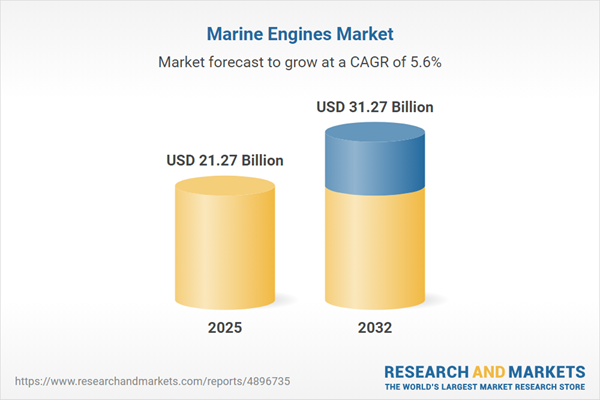Speak directly to the analyst to clarify any post sales queries you may have.
The marine engines market is undergoing significant transformation as technology acceleration and regulatory change alter how operators and suppliers approach compliance, competitiveness, and operational efficiency. Senior executives require timely, actionable intelligence to navigate challenges around modernization, sustainability, and global supply chain continuity.
Market Snapshot: Marine Engines Market Size and Growth Overview
The marine engines market is valued at USD 20.15 billion in 2024, projected to surpass USD 21.27 billion in 2025 and USD 31.27 billion by 2032, reflecting a consistent CAGR of 5.64%. Robust demand spans commercial, military, fishing, and recreational applications, with modernization programs, emissions mandates, and technology upgrades driving investment in advanced engine architectures. Companies continue to prioritize efficiency, emissions reduction, and standardization across global fleets, sustained by progress in engine design, emissions control, and digital optimization. The marine engines market maintains relevance in mature economies and fast-growing regions as evolving compliance requirements and operational efficiency remain central to long-term strategy.
Scope & Segmentation: Core Dimensions of the Marine Engines Market
- Product Types: Inboard, Jet Drive, Outboard, Stern Drive. Each propulsion category supports vessel customization, matching performance and flexibility needs across different commercial and technical use cases.
- Fuel Types: Diesel, Electric, Gasoline. Diverse fuel options allow operators to align propulsion strategies with sustainability objectives, regulatory demands, lifecycle cost management, and fleet maintenance models.
- Applications: Commercial, Fishing, Military, Recreational. Product performance is shaped by the requirements of each segment: commercial fleets seek extended uptime, military users require advanced reliability and redundancy, and recreational sectors favor simplified navigation and predictable service.
- Distribution Channels: Aftermarket, OEM. Original equipment manufacturers deliver integrated propulsion packages, while aftermarket channels provide essential lifecycle support, retrofits, and ongoing system upgrades.
- Geographies: Americas, Europe, Middle East & Africa, Asia-Pacific. Regional analysis covers mature and high-growth areas, enabling organizations to track evolving local policies, supply chain strategies, and sector demand across the United States, Canada, Europe, China, India, and beyond.
- Technology Focus: Digital twins, predictive maintenance, exhaust aftertreatment, hydrogen and alternative fuel integration, connectivity, modular engine architecture. These capabilities reinforce compliance, promote lifecycle efficiency, and elevate operational resilience globally.
- Featured Companies: Wärtsilä Corporation, MAN Energy Solutions SE, Rolls-Royce Power Systems GmbH, Caterpillar Inc., Cummins Inc., Yanmar Co., Ltd., Mitsubishi Heavy Industries, Ltd., Volvo Penta AB, Kawasaki Heavy Industries, Ltd., Hyundai Heavy Industries Co., Ltd. These market leaders champion research, innovation, and global technology deployment.
Key Takeaways: Strategic Insights for Senior Leaders
- Digital transformation and decarbonization directives are reshaping R&D priorities and capital allocation, resulting in swift adoption of clean propulsion technologies and influencing long-term industry positioning.
- Hybrid and electric propulsion platforms are gaining relevance as operators update vessels and port infrastructure to comply with emissions standards, offering fresh opportunities for differentiation.
- Alternative fuel initiatives—including hydrogen and biofuel trials—are expanding as regulatory guidance evolves and organizations embrace innovations in energy supply across vessel categories.
- Advancements in connectivity, analytics, and artificial intelligence are enhancing asset and fleet management by enabling more responsive maintenance planning and total cost control.
- Distinct customer priorities persist: commercial operators seek reliability and cost visibility; defense agencies invest in security and redundancy; recreational users emphasize user-friendly systems and simplified support.
- Strengthening supply chain resilience through regional partnerships and expanded supplier networks is increasingly vital, as operators adapt to geopolitical risk and seek uninterrupted operations.
Tariff Impact: Navigating the 2025 U.S. Measures
Anticipated U.S. tariffs in 2025 are prompting manufacturers and buyers to redesign marine engine supply chains to mitigate added costs. Decision makers are prioritizing regional sourcing, building relationships with domestic suppliers, and shifting toward modular production. These moves foster flexibility, protect operations, and allow businesses to manage procurement budgets effectively amidst shifting regulations.
Methodology & Data Sources
This report relies on rigorous secondary research, interviews with senior industry stakeholders, and comprehensive data triangulation. Insights are grounded in technical documentation, prevailing regulatory standards, and benchmarking, with validation against executive priorities for accuracy and relevance.
Why This Report Matters: Actionable Intelligence for the Marine Engines Market
- Support proactive adaptation to new propulsion technologies and regulatory changes influencing investment, procurement, and planning decisions in the marine engines market.
- Assess emerging risks and opportunities in propulsion segments, particularly related to alternative fuels, innovative engine designs, and evolving regional supply chains.
- Gain detailed insight into the competitive landscape for strategic positioning, collaboration, and building resilient operations in dynamic marine environments.
Conclusion
Dynamic regulatory environments, technological innovation, and increasingly complex supply chains are shaping the future of marine engines. This analysis offers strategic guidance, equipping senior leaders to steer through ongoing transformation and achieve sustainable growth.
Additional Product Information:
- Purchase of this report includes 1 year online access with quarterly updates.
- This report can be updated on request. Please contact our Customer Experience team using the Ask a Question widget on our website.
Table of Contents
3. Executive Summary
4. Market Overview
7. Cumulative Impact of Artificial Intelligence 2025
List of Figures
Samples

LOADING...
Companies Mentioned
The key companies profiled in this Marine Engines market report include:- Wärtsilä Corporation
- MAN Energy Solutions SE
- Rolls-Royce Power Systems GmbH
- Caterpillar Inc.
- Cummins Inc.
- Yanmar Co., Ltd.
- Mitsubishi Heavy Industries, Ltd.
- Volvo Penta AB
- Kawasaki Heavy Industries, Ltd.
- Hyundai Heavy Industries Co., Ltd.
Table Information
| Report Attribute | Details |
|---|---|
| No. of Pages | 181 |
| Published | October 2025 |
| Forecast Period | 2025 - 2032 |
| Estimated Market Value ( USD | $ 21.27 Billion |
| Forecasted Market Value ( USD | $ 31.27 Billion |
| Compound Annual Growth Rate | 5.6% |
| Regions Covered | Global |
| No. of Companies Mentioned | 11 |









